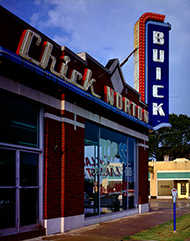D.B. Stovall worked for almost 10 years as a professional photographer
after graduating from the Rochester Institute of Technology in the
mid-'70s, doing mostly industrial work and graphic design for the
Department of Energy in Germantown.Pursuing
his own artistic interests, he took pictures with an old 1960s Calumet,
a bellowed, large format, 4- by 5-inch view tripod camera. Stovall's
subjects then were the seemingly everyday gas stations, pump houses,
barbershops, factories, auto dealers and mills that dotted the cities
and small towns he stumbled across on day trips and vacations. But
until recent advances in digital technology, Stovall wasn't able to
turn those pictures, taken on transparency film, into the kind of
large, detailed prints that he could show at galleries. For decades his
work sat idle. Now on display for the first time ever at the Delaplaine
Visual Arts Education Center in Frederick, those 30-year-old
photographs, saturated with color, reveal the nuanced design of
mid-century American storefront architecture from Morgantown to North
Platte, Nebraska, to Tulsa and Cheyenne. Newer photos taken from
locales like Reading, Pa., Luray, Va., and nearby Woodsboro, maintain
the same style and theme, what Stovall calls, "American Vernacular,"
the title of the exhibition, on view through March 3. "I've
always been drawn to older buildings, to the architecture," Stovall
said. "The care that people took in the design is amazing, factories
with complicated filigree and mosaics -- the name of a mill in
hard-carved stone -- they didn't have do that. It could've just been a
windowless square box. It took time and money." The 17 prints in
the second-floor Hall Gallery exhibition space include a framing of
"Chick Norton Buick" on a Technicolor corner in downtown Tulsa; a
pink-tile, hand-painted signed movie house in Lura; and Rocco Cambria's
red brick, throw-back barbershop in Reading. The portrait of a
neon Derby gas station soaking in a violet sunset in rural Nebraska
instantly recalls images of long country road trips for anyone who has
ever hit the open highway. "My earliest attempts at photography
as a youngster gravitated towards the everyday; parked automobiles,
storefronts and taverns, gas stations and garages," Stovall said in his
artistic statement accompanying the show. He added that during his
formal art education, he was influenced by American photographer Walker
Evans (1903-1975), noted for his work documenting the Great Depression
for the Farm Security Administration, and French photographer, Eugene
Atget (1857-1927), who documented the architecture and city life of
turn-of-the-century Paris. Despite his art education and decades
of interest in photography, Stovall had basically stopped taking
pictures about 20 years ago after a career in electrical engineering. It
wasn't until he saw a cable television program on historical Silver
Spring in 2006, which inspired him to dig up his previous work, that he
began taking pictures again. Coincidentally, digital technology,
software and printing, he soon learned, had improved to the point where
his transparencies could be translated into rich prints. Several of his
photos from his high school days were later published in a book about
Silver Spring. "I looked at my old pictures and thought, 'they're
not bad, I should do something with these,'" Stovall said. "And then I
looked at my view camera, which had been packed away. I figured the
bellows were probably cracked, but they weren't." And so he started
taking pictures again. Stovall said that his photographs, past
and present, are not intended as an ode to nostalgia or "Americana."
However, he cannot dismiss those feelings come forth from his work,
especially his older photos -- many of stores and building have
dramatically changed or no longer exist. Instead, he insists,
his work is motivated by the conscious recognition that he is
photographing and framing the creative efforts of others: the
architects, artisans and craftsmen who took pride in the design and
labor of everyday buildings. He's also aware as well --
although there are no people visible in his shots -- that whether it be
a small warehouse or barbershop or movie house, these are the places
where human activity thrives on a daily basis. Or once thrived, as in
the case of an abandoned factory in Allentown, Pa. "I work at
documenting what I know to be the American Vernacular: things that seem
mundane or commonplace to others yet define our existence," Stovall
said. "When I was searching for a name, something that would describe
what I do," he added, "people I talked to understood what 'American
Vernacular' meant. I think people get it."
|










